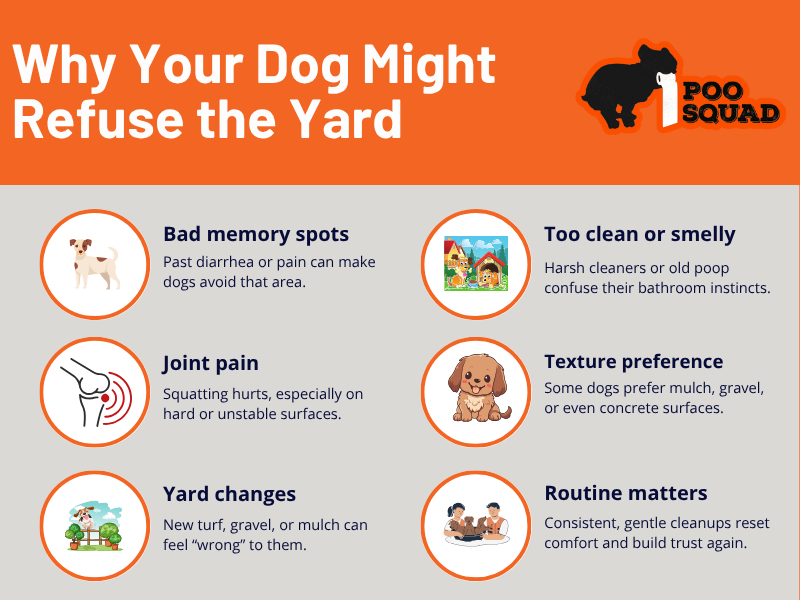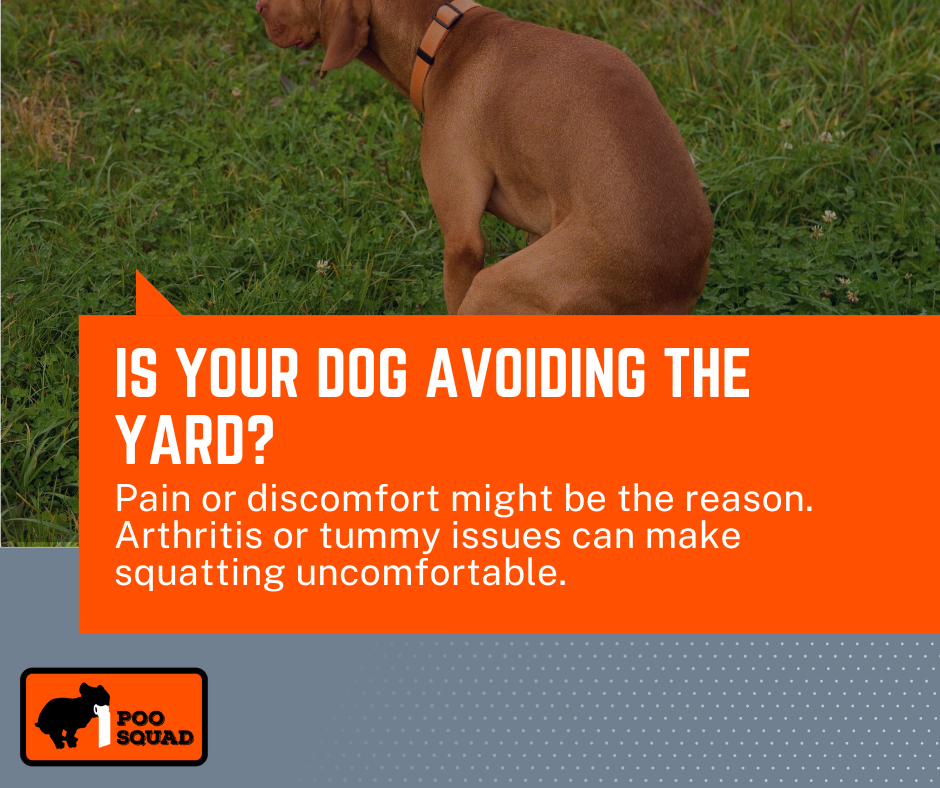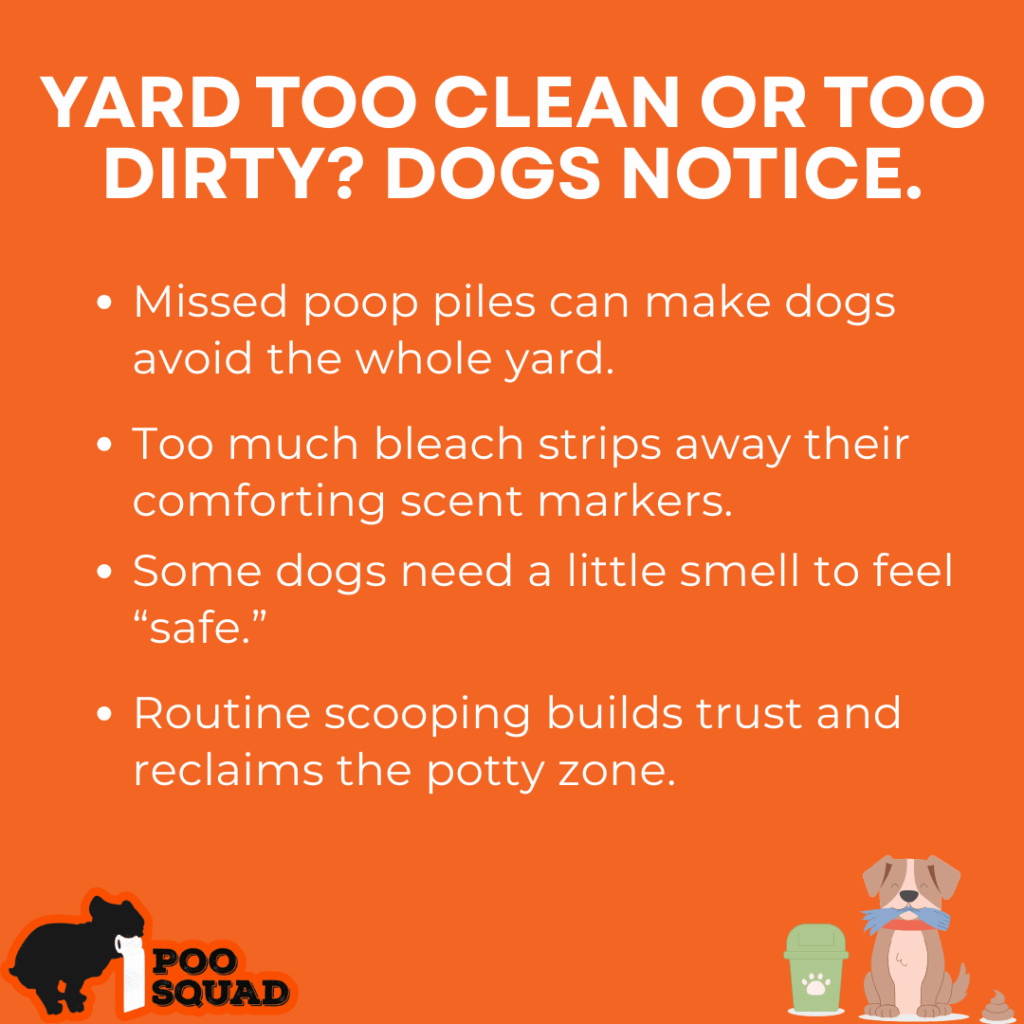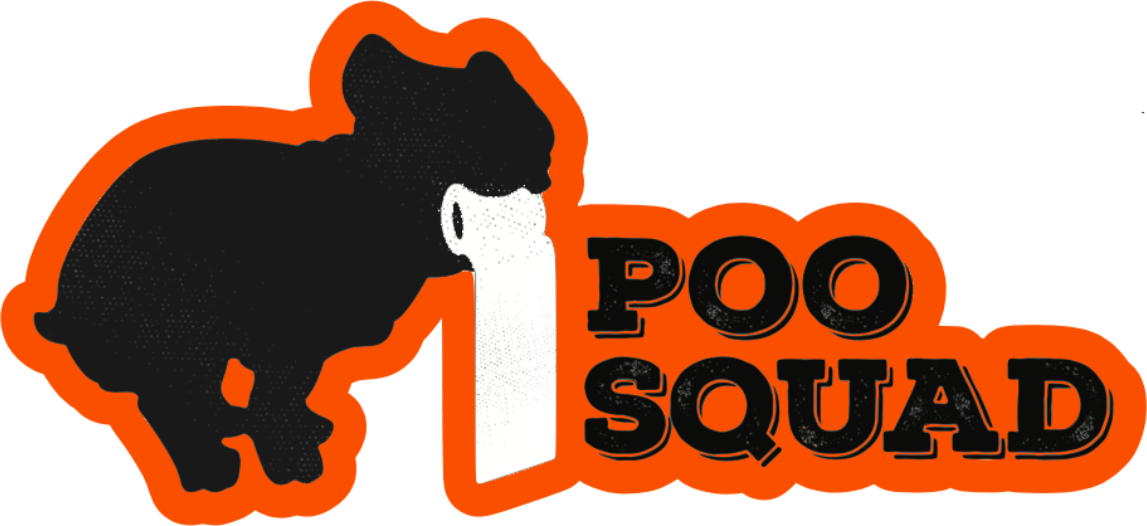Why Your Dog Won’t Poop in the Yard (And How to Fix It)
Dogs often refuse to poop in the yard due to environmental discomfort, scent confusion, surface preferences, medical pain, or disrupted routines. Common triggers include new turf, strong cleaners, past trauma, or overstimulation. Solutions include leash-led potty training, establishing a consistent schedule, designating a specific potty zone, and using scent-aware yard sanitation.

To fix the issue:
- Use a leash to reintroduce backyard pooping
- Create a designated spot with a preferred texture
- Maintain consistent timing and reward behavior
- Address scent disruptions from over-cleaning
- Rule out medical issues with a vet visit
Professional poop scooping and yard deodorizing services help reset behavior by providing a clean, familiar environment that reinforces safe and reliable elimination habits.
Your Dog Doesn’t Feel Safe or Comfortable in the Yard
Not every backyard feels like a safe space for your dog. Sounds, scents, layout, and even past experiences can shape how your dog reacts. If they’re hesitant or pacing without doing their business, chances are it’s not only mood, it’s comfort, confidence, and familiarity.
It’s overstimulating or too unfamiliar
Some dogs struggle to relax in a yard that’s visually busy or packed with smells from neighboring dogs, squirrels, or leftover barbecue. Others may feel uneasy if it’s a brand-new space they haven’t claimed as their own yet.
Dogs rely on scent to feel secure, and if they haven’t built that “bathroom confidence,” hesitation is expected.
We’ve met pups who wouldn’t go anywhere near the yard until their humans added fencing, cleaned up distractions, or introduced familiar smells. Even overgrown landscaping or a noisy HVAC unit nearby can throw them off.
That’s why our yard deodorizing and sanitizing service can make a big difference; dogs need a space that smells like theirs, not like old mildew and chaos.
Scent overload (or lack of it)
If your dog has never gone in the yard before, or if the space was recently sanitized too well, it might feel like an empty canvas, and that’s intimidating. Dogs like to return to places they’ve marked. Reintroducing scent gently (with a past poop or a designated potty corner) can rebuild that confidence.
Some owners overcorrect with strong cleaners or deodorizers that can repel dogs. A space that smells like chemicals or cleaning solution feels foreign to them. Stick to pet-safe, scent-neutralizing cleaners that don’t wipe out their internal “poop map.”
A Medical or Physical Issue Might Be the Cause

Sometimes, it’s not about the yard at all; it’s about how your dog feels. Discomfort, illness, or aging can make the simple act of squatting painful. When that’s the case, even the most inviting backyard can become a place they actively avoid.
Joint pain, digestive issues, or trauma
If your dog hesitates to squat, paces more than usual, or holds it in for unusually long stretches, something deeper might be going on. Conditions like arthritis, hip dysplasia, or digestive discomfort can turn elimination into an uncomfortable experience. For these pups, softer grass or uneven terrain can feel unstable, discouraging them even more.
We’ve even seen dogs who’ve had a bad episode, like diarrhea or constipation, avoid the spot where it happened, associating the yard with pain or embarrassment. It’s more common than you’d think. If your dog’s suddenly changed their behavior, a vet check is a good first step before trying any behavioral fixes.
This is also why regular cleanup through our residential poop scooping service helps, eliminating physical hazards and making the yard more inviting for dogs who need a gentler space to feel at ease.
Next, let’s talk about where they want to go. Because if it’s not the yard, it might be about what’s under their paws.
Your Dog Has a Surface Preference You Haven’t Noticed
Every dog has preferences, even when it comes to pooping. Some like grass. Others won’t go unless it’s gravel, mulch, or even concrete. If your dog is skipping your yard but going on walks or in random spots, it may be a texture thing.

Grass? No thanks.
Dogs raised in:
- kennels,
- city apartments,
- or on pee pads
may not associate grass with bathroom time. One customer told us her rescue would only go on gravel for months because that’s what he’d grown up with. Another pet parent realized their dog had spent years using mulch at a dog park, and nothing else would do.
If you’ve recently made upgrades like adding turf or re-landscaping, don’t be surprised if your dog avoids the yard now. It doesn’t mean they’re being difficult. It means their paws are confused.
To ease them in, try creating a temporary spot with their preferred texture:
- a small patch of gravel,
- straw,
- or even a square of old turf.
Once your dog builds trust in the new spot, you can gradually encourage them to expand from there.
Getting your dog comfortable with where they go is the first step. But how clean is that space? That’s the next one. Let’s talk about the real reason many dogs walk right past their yard like it owes them money.
The Yard Isn’t Clean Enough (From Their Perspective)
To you, the yard might look perfectly fine. But to your dog’s ultra-sensitive nose, it could smell like a chaotic mix of:
- old poop particles,
- cleaning chemicals,
- and whatever the wind blew in.
For a lot of dogs, that’s enough to shut down their bathroom plans entirely.
When “clean” is not dog-clean
If poop hasn’t been picked up consistently, even a few missed piles can signal to your dog that:
- This is not a bathroom. It’s a minefield.
On the flip side, overly sanitized spaces can strip away the scent markers they rely on to feel comfortable.
We’ve had clients tell us they’re scrubbing with bleach, spraying deodorizers, and wondering why their dog still prefers the sidewalk. The truth is, both overcleaning and undercleaning can send the same message: “This is not a safe place to go.”
That’s where routine matters. A freshly scooped yard done the right way, with pet-safe sanitation and no residue, is your best chance at resetting the space. It’s part of why our yard sanitation and deodorizing service helps so many clients rebuild that trust between dog and grass.
Your Dog’s Routine or Triggers Have Changed
Dogs thrive on consistency. So when their schedule, household rhythm, or even the route of their walk changes, it can throw their entire elimination pattern off. What feels like a minor adjustment to you might feel like chaos to them.
A shift in timing, location, or leadership
Did you move homes?
Add a baby?
Start working a new shift?
Even subtle disruptions, like a different person walking the dog or construction noise near their favorite potty corner, can make dogs delay pooping or choose somewhere “safer.”
We’ve seen this happen most often during seasonal transitions or after vacation. One pet parent came home to find her dog hadn’t pooped in the yard for five straight days. He was holding out for the walk because he didn’t trust the new yard yet.
A good fix?
Anchor your routine. Feed your dog, then take them out to the yard at the same time every day. Stand with them. Use a leash if needed. And when they finally go, celebrate like you won a reality show. Reinforcement matters.
And if walks are still in the mix, don’t fall into this next trap, we see it more than you’d think.
You May Have Accidentally Trained Them to Poop Elsewhere
We don’t mean to do it, but sometimes our routines condition dogs to hold it until the moment is only right, and that moment often is not the backyard. Over time, this can become an ingrained habit that’s surprisingly tricky to reverse.
Walk-first, poop-later… forever
If your dog only gets to walk after they poop, they may start holding it in the yard to extend their outdoor time. We’ve heard owners say things like, “He won’t go unless we walk at least 10 minutes,” and that’s the exact pattern being reinforced.
Take your dog to the yard first, wait for the poop, then go for a walk. Over time, they’ll learn that yard pooping equals more fun, not less.
Leash-trained minds in an off-leash space
Some dogs were trained to potty on leash, whether from crate training, rescue environments, or apartment living. Drop that leash in the backyard, and they’re not sure what to do. In this case, leashing them in the yard can make things click again.
It’s also worth mentioning that if your dog has ever been scolded for an accident indoors, they might associate “being seen” with punishment. That can drive them to poop in secret places, like under a tree or even back inside.
If that’s happening, don’t panic. It’s fixable, but it may involve rewiring what “safe” means in their mind. And believe it or not, the size of your yard can also play a role.
The Yard Feels Too Small (or Too Much Like Home)
To some dogs, the backyard is not a designated bathroom; it’s part of their living space. And like we wouldn’t drop our pants in the middle of the kitchen, they’re not too keen on pooping where they feel like they “live.”
When space blurs the lines
Small yards, especially in townhomes or urban settings, can confuse dogs. If their food bowl is in sight or their favorite play area is only a few steps away, it may feel unnatural to use that space for bathroom business.
We’ve also seen dogs who grew up in larger areas (like farms or suburban homes) suddenly refuse to go after moving to a smaller, enclosed yard. It’s not stubbornness, it’s spatial identity.
A smart workaround?
Create a dedicated potty corner. Use mulch, pea gravel, or a low border to define the spot. Walk them to that area on-leash and reward them heavily when they go. Over time, this builds clear boundaries between “yard” and “toilet.”
It’s a small fix that makes a big difference, especially when paired with our residential poop scooping to keep that area clean, consistent, and inviting. But if your dog’s issue is not space or comfort, it might only be scent memory.
Your Dog’s Scent Map Has Been Wiped Out
Dogs navigate the world with their noses, and when it comes to bathroom habits, scent is everything. If your yard doesn’t smell like a bathroom to your dog, they might genuinely not recognize it as one. That’s where scent memory, and sometimes lack of it, comes into play.
A clean slate isn’t always a good thing
New homes, renovations, heavy rain, or even aggressive sanitizing can wipe out the scent cues your dog relies on. When there’s no familiar trace of past eliminations, your dog might keep searching for “their spot”, and if they don’t find it, they hold it.
We’ve had new customers tell us, “He used to poop like clockwork at the dog park, but hasn’t gone once since we moved.” That’s because dogs don’t remember where they went; they remember what it smelled like when they did.
If this sounds familiar, a temporary fix is to leave one poop pile in the yard for a day or two. It reestablishes scent without overwhelming the space. Then, once your dog’s back in the groove, scoop it and return to normal routine, or better yet, hand it off to us with scheduled poop scoop service.
By rebuilding the scent trail, you’re giving your dog confidence to go again. But sometimes it’s not about the smell, it’s about your dog needing a little help resetting everything from the ground up.
How to Reset the Behavior (Without Losing Your Mind)
When nothing seems to work and your yard has turned into a canine catwalk with zero action, it’s time for a structured reset. This is not about discipline, it’s about building new habits that feel safe, rewarding, and familiar for your dog.
5-step backyard potty reset
- Pick a quiet time: Choose a low-distraction window when your dog is calm and the environment is still.
- Use a leash, even in the yard: This creates focus and mimics walk-time cues without leaving your property.
- Designate a potty spot: Use mulch, turf, or gravel in one corner of the yard and return to it consistently.
- Reward immediately: Bring high-value treats and throw a mini celebration every time they go.
- Keep the walk going after: If walks follow pooping, don’t end them right after. This breaks the “hold it for more walk time” habit.
Most dogs respond quickly to this kind of structure. But if yours doesn’t, or if the behavior includes signs of pain or prolonged holding, it might be time to involve a vet or professional trainer.
And yes, a cleaner yard makes this whole process easier. A well-maintained space, especially one that’s scooped regularly and sanitized gently, encourages dogs to treat it like a bathroom again. Our yard deodorizing services can support this transition by keeping it both inviting and consistent.
Bonus Tools and Services to Make This Easier
Building reliable poop habits is not only about what you do; it’s also about setting your dog up for success with the right environment and support. A little outside help can go a long way in turning your backyard into a place your dog wants to go.
Sanitation that resets the scene
Sometimes, all your dog needs is a clean, neutral-smelling space that still carries their scent trail. We offer yard sanitation and deodorizing services that walk that line perfectly, removing offensive or confusing smells without making the yard smell like a chemical lab.
This service is especially helpful after a big move, landscape upgrade, or potty training relapse. It creates a baseline where your dog can start fresh, but not disconnected from their routine.
Trusted hands and tools on the ground
Whether your pup’s picky, anxious, or medically recovering, consistency matters. And so does trust. Our residential poop scooping ensures the yard stays clean and familiar without relying on rushed DIY jobs or the kid down the street.
Plus, if you’ve got a runner, our pet ID tag and profile program adds an extra layer of safety to keep your dog accounted for and easily returned.
You’re Not a Bad Dog Owner, This Is Fixable
It’s easy to feel defeated when your dog refuses to use the yard, especially after you’ve tried everything from treats to turf. You might even start wondering if you’ve failed in some invisible way. But trust us, this is a common issue, and it doesn’t make you a bad pet parent.
Dogs are creatures of habit, comfort, and very specific preferences. When something disrupts their sense of safety or routine, their behavior changes. That doesn’t mean it’s permanent.
We’ve helped countless owners, from overwhelmed families to new rescue adopters, navigate this same challenge and come out the other side with a fully yard-trained pup.
With a bit of structure, patience, and a clean slate (literally), things get better. Whether you reset your yard with consistent scooping services, establish a go-to potty zone, or simply stop fighting over whose turn it is to scoop on the weekends, we’re here to help you get your time, yard, and peace of mind back.
Because at the end of the day, helping dogs do their business is our business, and no one takes it more seriously (or more personally) than we do.
Author: Chief Scooper
Jamie Coones is the founder of Poo Squad. He started the original location in Manhattan, KS in 2017 and has since licensed the brand to another 20 other owners with locations across the country.
